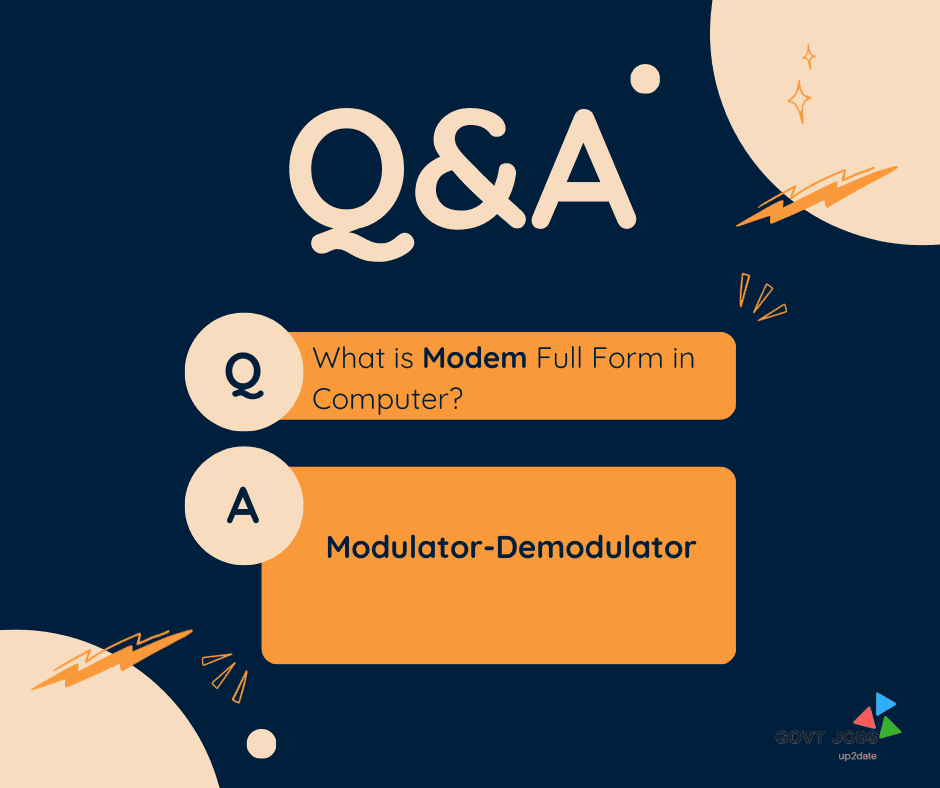
What does the term “modem” stand for in computer technology?
A) Memory-Demolisher
B) Modulator-Demodulator
C) Multi-Device
D) Microprocessor-Decoder
Answer:
B) Modulator-Demodulator
More Details on Modem
Definition of Modem:
- Modem stands for “Modulator-Demodulator.”
- It is a communication device that converts digital data from a computer into an analog signal for transmission over analog communication lines (such as telephone lines) and vice versa.
Functionality:
- Modulation: Modems modulate digital data into analog signals for transmission.
- Demodulation: Modems demodulate incoming analog signals back into digital data.
Types of Modulation:
- Amplitude Modulation (AM)
- Frequency Modulation (FM)
- Phase Modulation (PM)
Types of Modems:
-
- Dial-Up Modem:
- Slower data transfer rates.
- Uses a standard telephone line.
- Commonly used in the past but now largely obsolete.
- DSL Modem (Digital Subscriber Line):
- Faster than dial-up.
- Uses existing telephone lines but provides a dedicated connection.
- Cable Modem:
- Uses cable television lines for data transmission.
- Provides higher data transfer rates compared to DSL.
- Fiber Optic Modem:
- Uses fiber optic cables for data transmission.
- Provides very high-speed internet connectivity.
- Wireless Modem:
- Uses radio waves for communication.
- Includes Wi-Fi modems and cellular modems.
- Dial-Up Modem:
Advantages and Disadvantages of MODEM
Advantages of MODEM
Connectivity: Modems enable devices to connect to the internet and other networks, facilitating communication and resource sharing.
Versatility: Different types of modems cater to diverse needs, offering options like DSL, cable, and wireless connectivity.
Accessibility: Modems provide internet access in various locations, making them essential for both residential and commercial use.
Disadvantages of MODEM
Disadvantages of MODEM are:
Limited Speed: Traditional dial-up modems offer slower speeds compared to broadband options, affecting data transfer rates.
Dependence on Infrastructure: Modem performance can be influenced by the quality and capacity of the underlying communication infrastructure.
Vulnerability: Modems are susceptible to security threats, and users need to implement measures like firewalls and encryption to protect against unauthorized access.
Conclusion
In conclusion, modems have played a pivotal role in the evolution of computer networking and internet connectivity. While they have advantages in terms of versatility and accessibility, users must also consider limitations such as speed constraints and security vulnerabilities. With advancements in technology, broadband options have largely replaced slower dial-up connections, offering faster and more reliable internet access.
Frequently Asked Questions
What does the term “modem” stand for?
Modem stands for “Modulator-Demodulator.”
What is broadband?
Broadband refers to high-speed internet connectivity that allows for the simultaneous transmission of multiple signals.
What are the advantages of using a modem?
Advantages include connectivity, versatility, and accessibility, catering to diverse internet access needs.
What are the disadvantages of modems?
Disadvantages include limited speed, dependence on infrastructure, and vulnerability to security threats.

